ashauler
None for me, thanks.
There are many places on the net to pick up seeds. The best way, imo, is to join a forum dedicated to tobacco growing and processing. Google fair trade tobacco.
Get the CigarPass web app up and running in under a minute!
Dive in and unlock the full experience of the CigarPass community today!
📱 Follow the simple steps to install the app and join the community on the go!
📲 Get the App Now!Stay connected, share your passion, and never miss a puff! 💨
Here is some info for those who want to grow their own tobacco.
1. Start your seeds indoors or in a green house 6-8 weeks before the last frost in your region. I use float trays, which are compartmentalized styrofoam trays that float in a bed of water. You can also use the seed starter trays available from most home and garden centers. I use a mixture of quality top soil and potting soil (50/50 mix), fill your trays and lightly pack the soil, and dampen with water. Then sow 2-4 seeds into each compartment. This can be hard to do, a little trick I use to make this easier is I take a business card or some type of rigid paper and crease it down the middle. Place some seeds on the paper, using a knife scrape the seeds onto the trays.

Leave the seeds on top of the soil. DO NOT cover with soil, the seeds need light to germinate.
2. After the seeds begin to grow once a week when you water them (keep the soil moist as the plants will dry out very quickly and die) using Miracle Grow or some type of plant fertilizer. If you can find it Miracle Grow for tomato plants is the best. Tobacco and tomato are from the same family Night Shade.Once they are about an inch tall, using tweezers remove the extra seedlings in each compartment, leaving only one plant per compartment. When the plants reach 6-8 inches tall, and if the danger of frost is over they are ready to transplant outside. They can handle quite a bit of sun light. I plant mine where they recieve direct sun light all day long with no issues of being sun burned. This is a pic of one of my float trays from last years crop. This tray has 55 individual compartments. the seedlings are 3-4 inches tall.
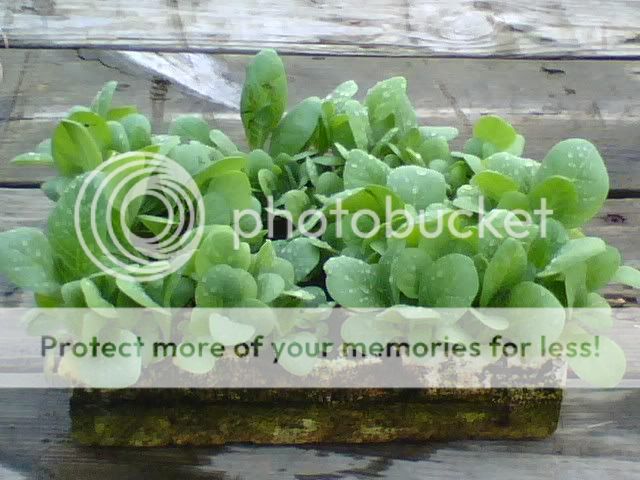
3. When transplanting outside Make sure to water them well as you plant them outside. If you choose to grow them in pots use large planters, or 5 gallon buckets work well also. You need a pot at least 14 inches in diameter or larger, to keep the plants from falling over when they get bigger. Some of the plants can reach 6 feet or taller. As they grow I feed them once a week with some type of plant fertilizer. One thing to consider if you plant these in your garden do not put them close to your tomatos. the nicotine from the plants will kill your tomato plants!!!! This pic is a short section of 2 rows about 2 weeks after transplanting, each row I had last year 80 plants.
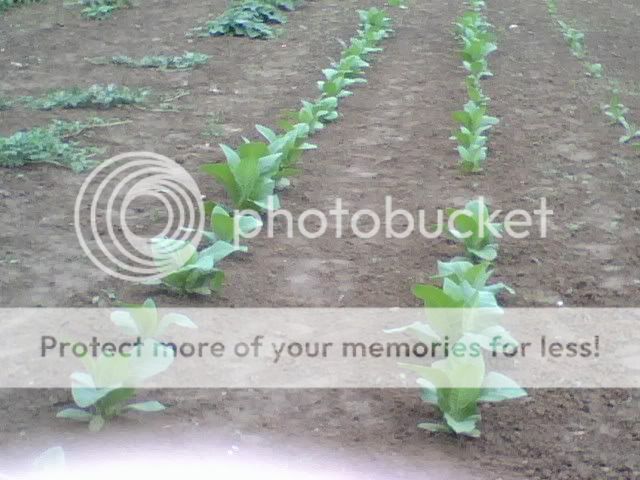
4. The bugs shouldn't become a problem until after they start to bloom. Now is when you have to make a choice. First option, if you leave the blooms on the plant you will have taller plants with more leaves, 30 or more but smaller leaves. Second option, break off the blooms, (this is called topping) you will have shorter plants with fewer leaves 20-26 but the leaves will be quite a bit bigger. I had some leaves last year close to 3 feet long. These pics are of the blooms and one of the leaves at 6 weeks or so.
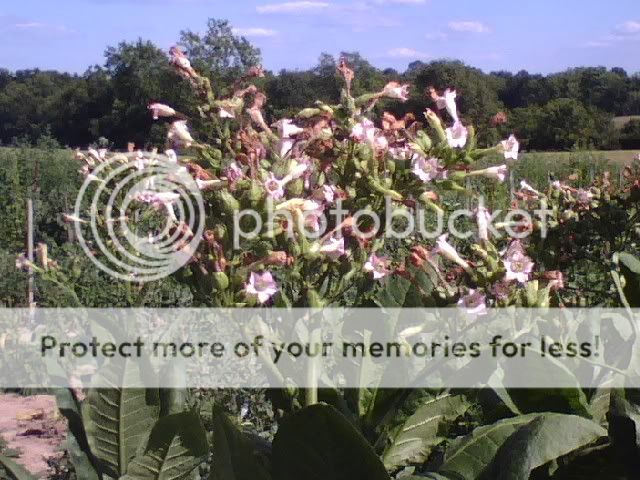
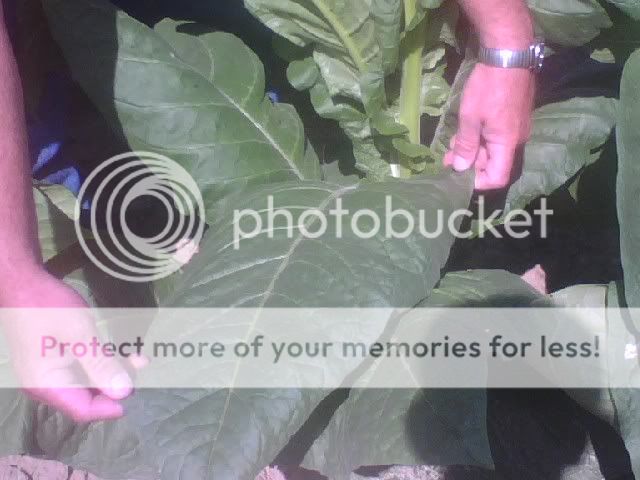
4. After the plants bloom they will become sticky and really start to smell good. This is when the insects will come calling. I use a mixture of finely ground tobacco 1 tablespoon, 1 tablespoon finely ground black pepper, 1 teaspoon dish washing detergent in 1 gallon of water. Spray the plants once a week, or after each rain. This will keep the bugs away. DO NOT use any type of systemic pesticide as it will be absorbed into the tobacco, then you if you smoke or chew it later!!!!!
5. Next thing is small leaves (suckers) will start to grow at the base of each leaf where it joins the stalk. These must be removed. We call this suckering the plant. If these are allowed to grow they will rob the main leaves of their nutrients, and won't grow as large. Here is a pic of a sucker.
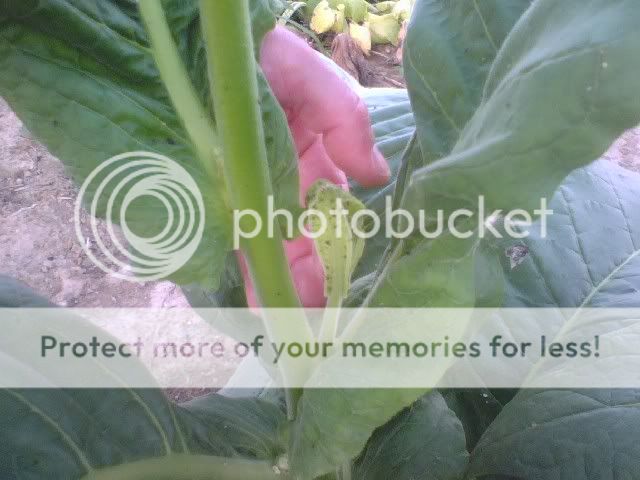
6. Now 2-4 weeks after the plants have bloomed you can start harvesting. This can be done by priming the plant a few leaves at a time as they ripen, or you can cut the whole plant. If you prime you can thread a string through the base of the leaf, or tie each leaf to hang and cure. If you cut the whole plant you can hang it to cure then strip the leaves later, My prefered method. Here is a pic of a wooden tobacco stick with 5 tobacco stalks speared, it weighs close to 80 pounds.

7. Hang your tobacco in a well ventillated barn, shed, or garage to cure. This will take 6 weeks or more depending on the temperature, humidity, and air movement. It's considered cured when it has a nice brown color. Be careful when handling cured tobacco as it will be very dry and brittle. You can bring it into case (make it pliable and easy to handle) by misting it with water or waiting for a couple of rainy days. It will absorb the moisture and be safe to handle. This is a pic of some hanging in the barn.
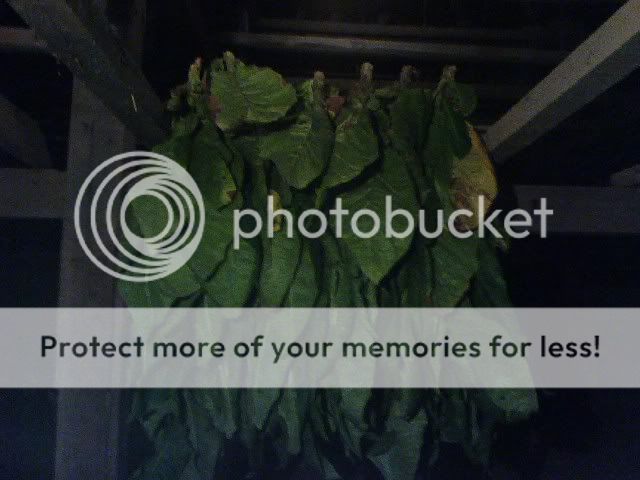
8. Now it's ready to ferment, I'll cover this later, I'm still learning. I don't want to post any misdirections.
Good luck, and feel free to contact me if you have any questions.
Brian,
Rod, would you pin this so that everyone can have easy access to this information?
Excellent post! I grew up in eastern North Carolina on a tobacco farm. I hated working in tobacco. I didn't really know what I wanted to do when I grew up but I knew what I did NOT want to do.....farm tobacco!Here is some info for those who want to grow their own tobacco.
1. Start your seeds indoors or in a green house 6-8 weeks before the last frost in your region. I use float trays, which are compartmentalized styrofoam trays that float in a bed of water. You can also use the seed starter trays available from most home and garden centers. I use a mixture of quality top soil and potting soil (50/50 mix), fill your trays and lightly pack the soil, and dampen with water. Then sow 2-4 seeds into each compartment. This can be hard to do, a little trick I use to make this easier is I take a business card or some type of rigid paper and crease it down the middle. Place some seeds on the paper, using a knife scrape the seeds onto the trays.

Leave the seeds on top of the soil. DO NOT cover with soil, the seeds need light to germinate.
2. After the seeds begin to grow once a week when you water them (keep the soil moist as the plants will dry out very quickly and die) using Miracle Grow or some type of plant fertilizer. If you can find it Miracle Grow for tomato plants is the best. Tobacco and tomato are from the same family Night Shade.Once they are about an inch tall, using tweezers remove the extra seedlings in each compartment, leaving only one plant per compartment. When the plants reach 6-8 inches tall, and if the danger of frost is over they are ready to transplant outside. They can handle quite a bit of sun light. I plant mine where they recieve direct sun light all day long with no issues of being sun burned. This is a pic of one of my float trays from last years crop. This tray has 55 individual compartments. the seedlings are 3-4 inches tall.

3. When transplanting outside Make sure to water them well as you plant them outside. If you choose to grow them in pots use large planters, or 5 gallon buckets work well also. You need a pot at least 14 inches in diameter or larger, to keep the plants from falling over when they get bigger. Some of the plants can reach 6 feet or taller. As they grow I feed them once a week with some type of plant fertilizer. One thing to consider if you plant these in your garden do not put them close to your tomatos. the nicotine from the plants will kill your tomato plants!!!! This pic is a short section of 2 rows about 2 weeks after transplanting, each row I had last year 80 plants.

4. The bugs shouldn't become a problem until after they start to bloom. Now is when you have to make a choice. First option, if you leave the blooms on the plant you will have taller plants with more leaves, 30 or more but smaller leaves. Second option, break off the blooms, (this is called topping) you will have shorter plants with fewer leaves 20-26 but the leaves will be quite a bit bigger. I had some leaves last year close to 3 feet long. These pics are of the blooms and one of the leaves at 6 weeks or so.


4. After the plants bloom they will become sticky and really start to smell good. This is when the insects will come calling. I use a mixture of finely ground tobacco 1 tablespoon, 1 tablespoon finely ground black pepper, 1 teaspoon dish washing detergent in 1 gallon of water. Spray the plants once a week, or after each rain. This will keep the bugs away. DO NOT use any type of systemic pesticide as it will be absorbed into the tobacco, then you if you smoke or chew it later!!!!!
5. Next thing is small leaves (suckers) will start to grow at the base of each leaf where it joins the stalk. These must be removed. We call this suckering the plant. If these are allowed to grow they will rob the main leaves of their nutrients, and won't grow as large. Here is a pic of a sucker.

6. Now 2-4 weeks after the plants have bloomed you can start harvesting. This can be done by priming the plant a few leaves at a time as they ripen, or you can cut the whole plant. If you prime you can thread a string through the base of the leaf, or tie each leaf to hang and cure. If you cut the whole plant you can hang it to cure then strip the leaves later, My prefered method. Here is a pic of a wooden tobacco stick with 5 tobacco stalks speared, it weighs close to 80 pounds.

7. Hang your tobacco in a well ventillated barn, shed, or garage to cure. This will take 6 weeks or more depending on the temperature, humidity, and air movement. It's considered cured when it has a nice brown color. Be careful when handling cured tobacco as it will be very dry and brittle. You can bring it into case (make it pliable and easy to handle) by misting it with water or waiting for a couple of rainy days. It will absorb the moisture and be safe to handle. This is a pic of some hanging in the barn.

8. Now it's ready to ferment, I'll cover this later, I'm still learning. I don't want to post any misdirections.
Good luck, and feel free to contact me if you have any questions.
Brian,
Rod, would you pin this so that everyone can have easy access to this information?
Click here to register for free. You'll gain full access to all features. If your account is not activated within 24 hours, contact us at contact@cigarpass.com with the username you are inquiring about. Thank you...

